Abstract
Sterol carrier protein 2 (SCP2) has been shown to be involved in intracellular transport and metabolism of cholesterol. However, there have been no reports concerning SCP2 in macrophages, the major source of atheromatous foam cells. We investigated whether SCP2 is present in rat peritoneal macrophages and determined the changes of SCP2 and its mRNA levels in macrophages during form cell formation induced by acetylated LDL (AcLDL). Immunoblot analysis and Northern blot analysis demonstrated that both SCP2 and its mRNA are expressed in rat peritoneal macrophages. Incubations with AcLDL caused a dose- and time-dependent increase of cellular esterified cholesterol, SCP2 and its mRNA in rat peritoneal macrophages. The inhibitor of acyl-CoA:cholesterol acyltransferase further enhanced AcLDL-induced increase of SCP2 protein and its mRNA. Incubations with 25-hydroxy cholesterol also caused a dose-dependent stimulation of SCP2 gene expression in macrophages, while incubation with maleylated BSA had no effect. These results suggest that the increment of cellular-free cholesterol is responsible for enhanced SCP2 gene expression in macrophages. The enhancement of SCP2 gene expression by AcLDL suggests that SCP2 may play an important role during foam cell formation induced by AcLDL which may be most important step for the atherosclerosis.
Full text
PDF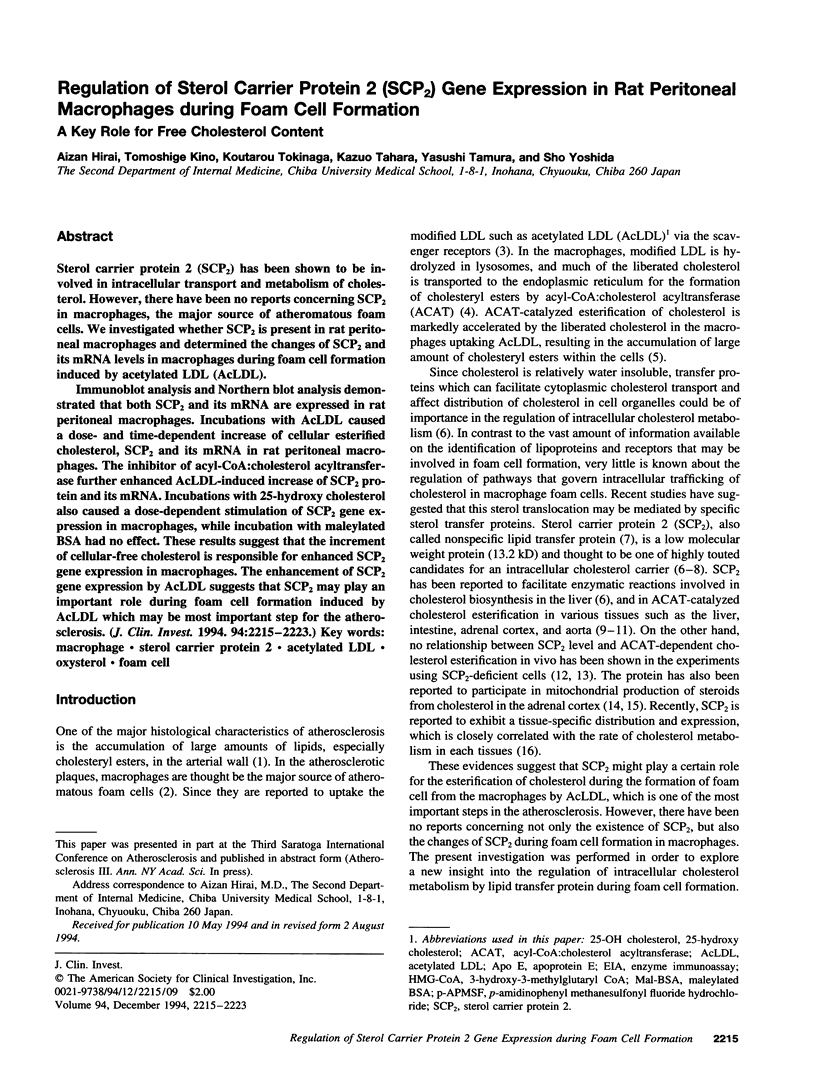
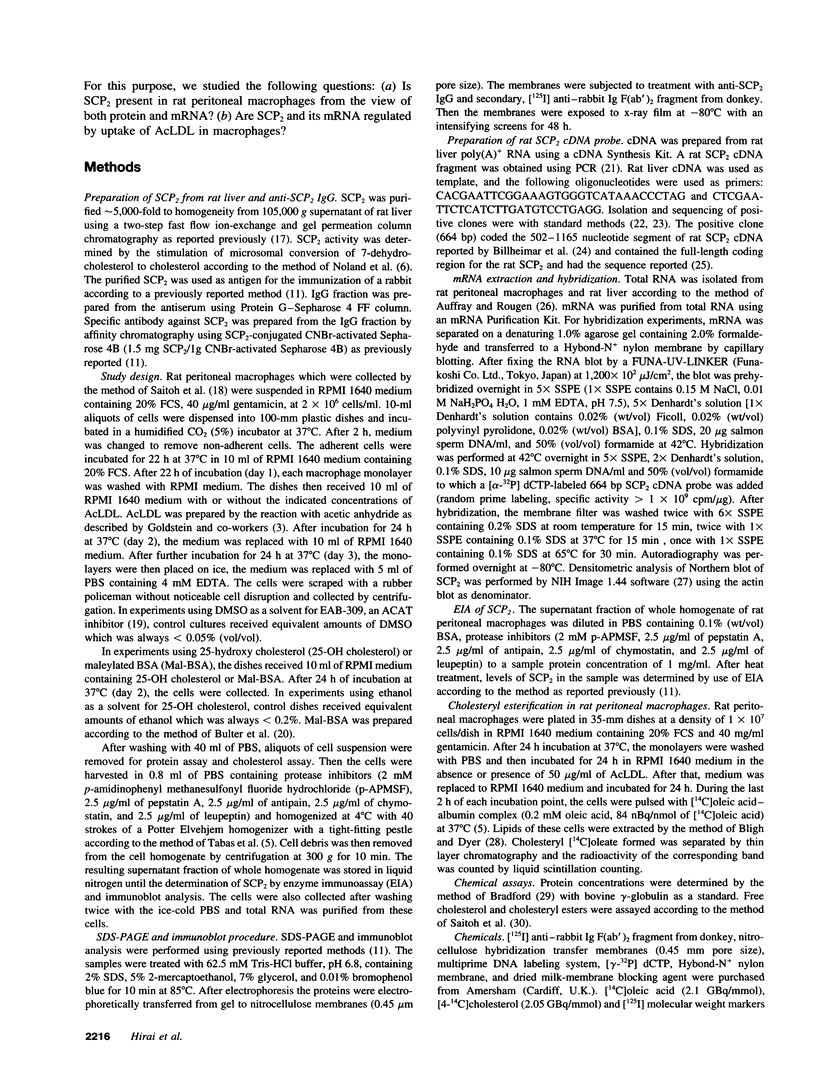
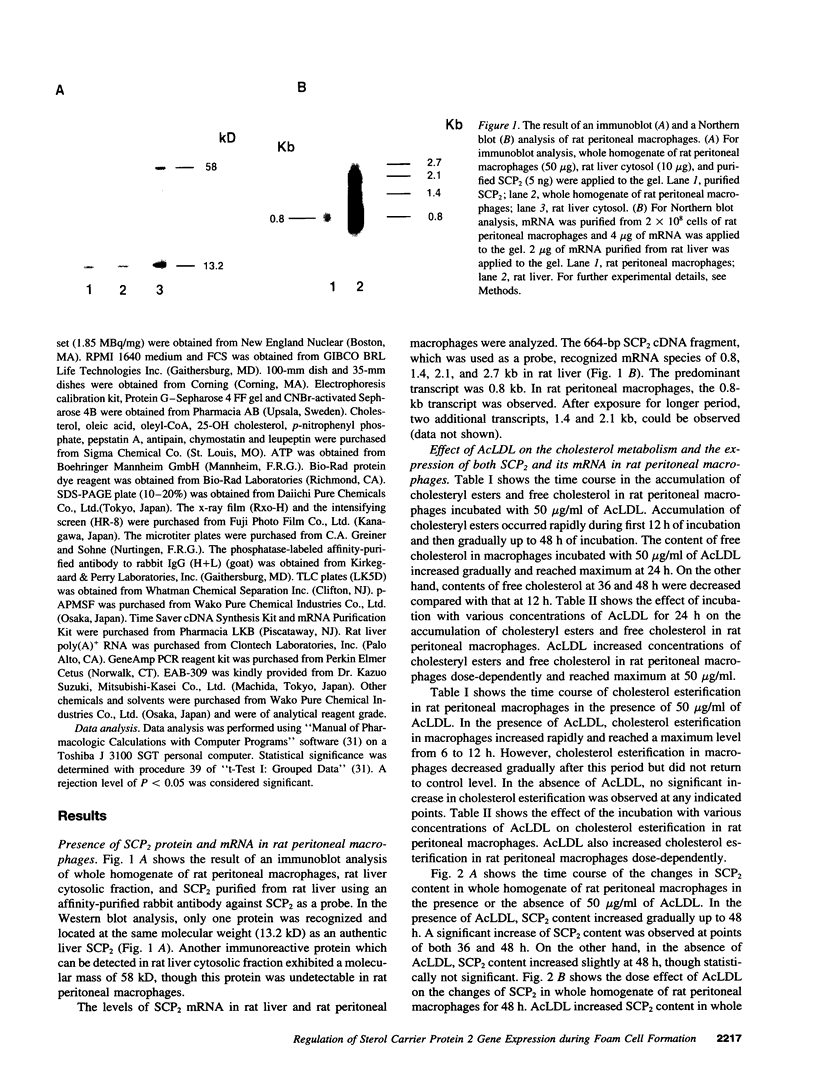
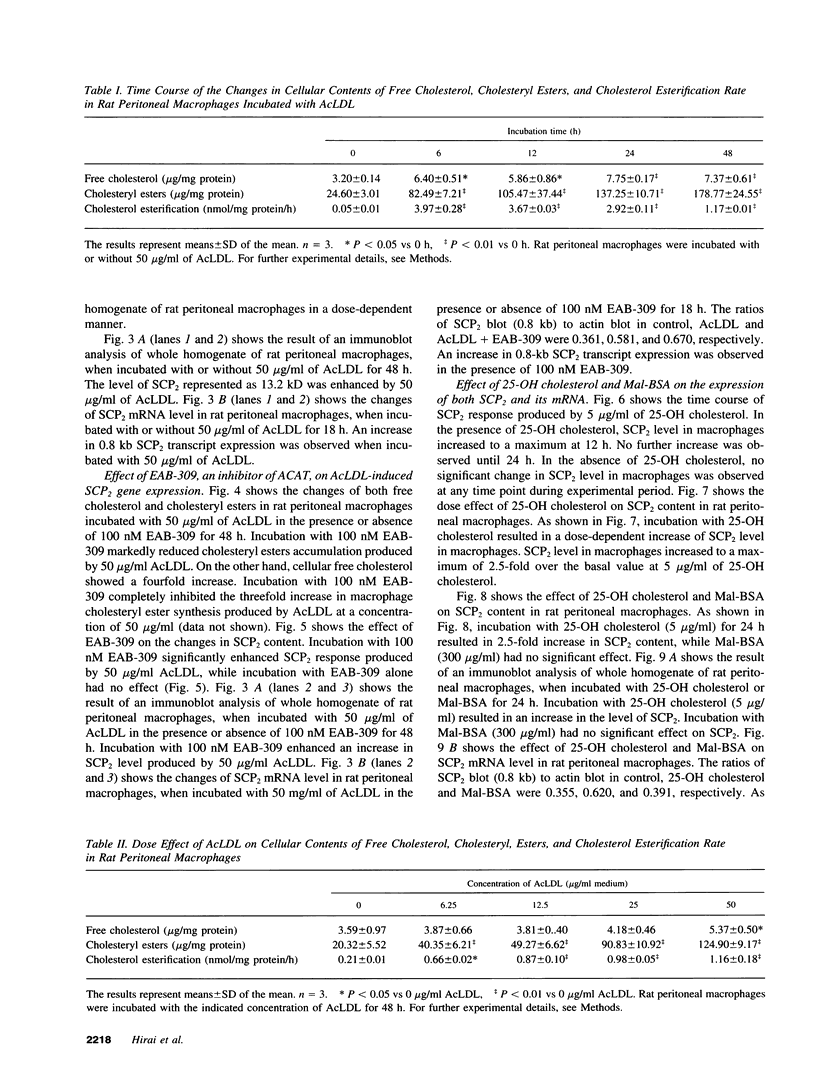
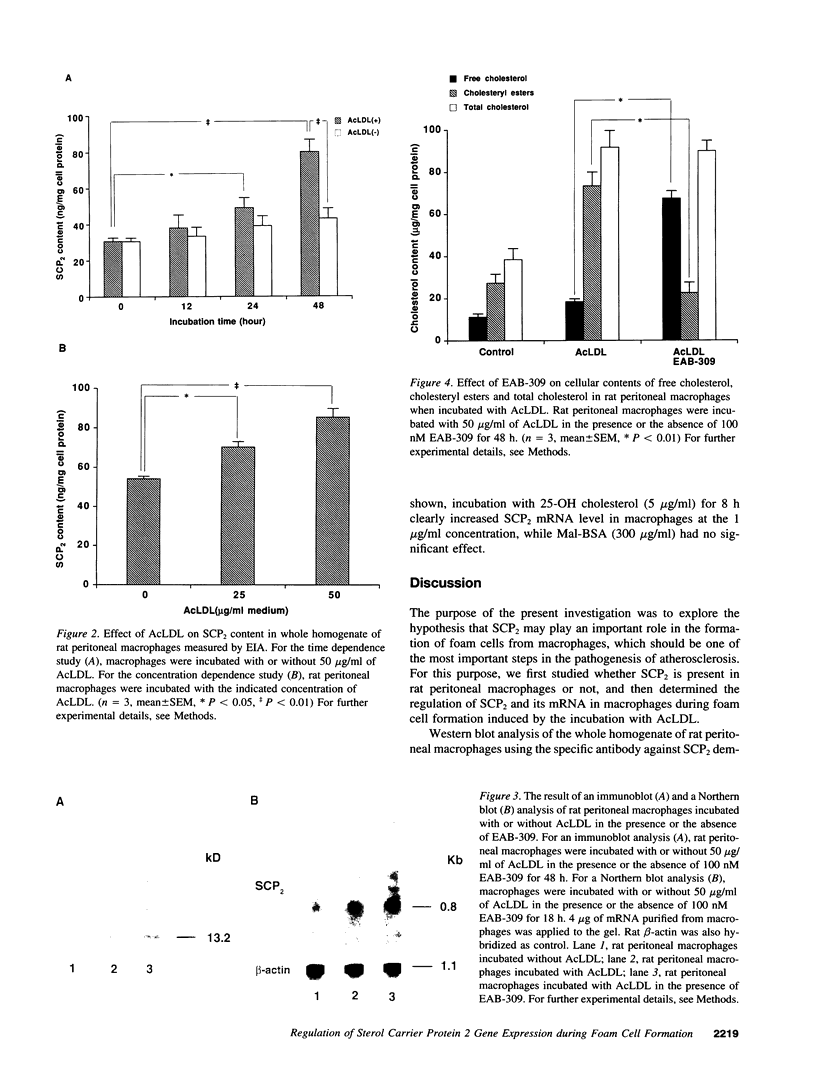
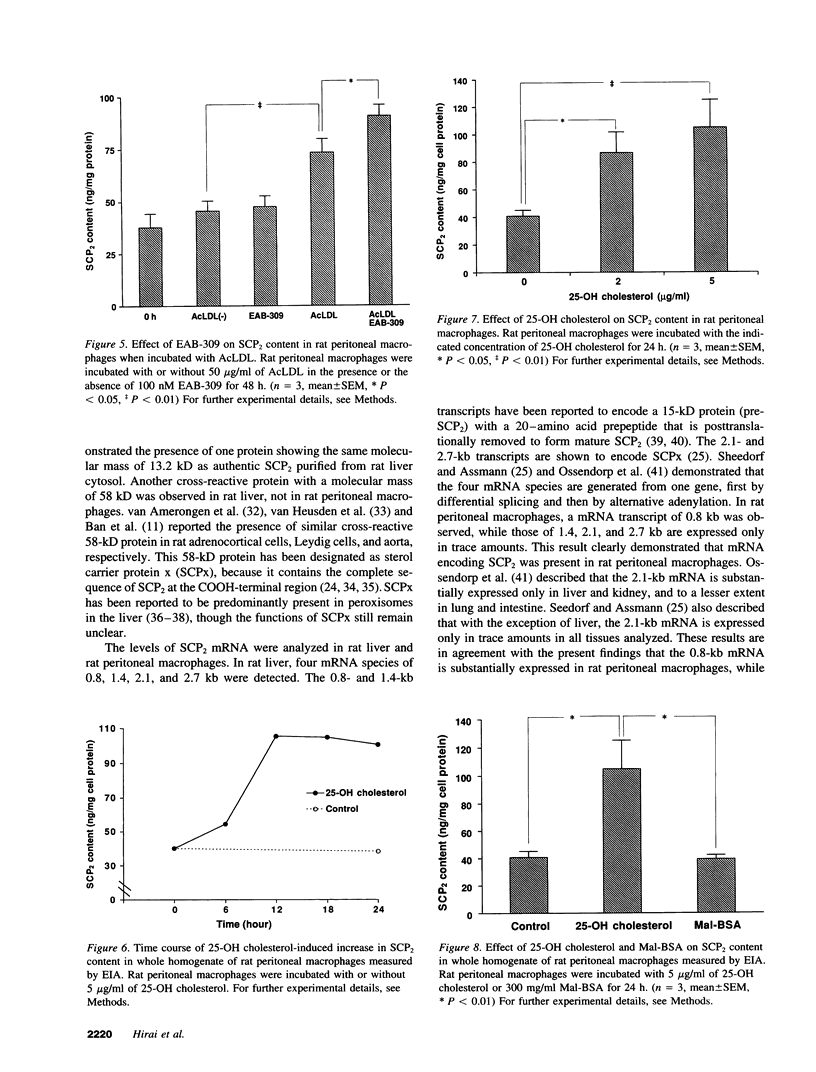
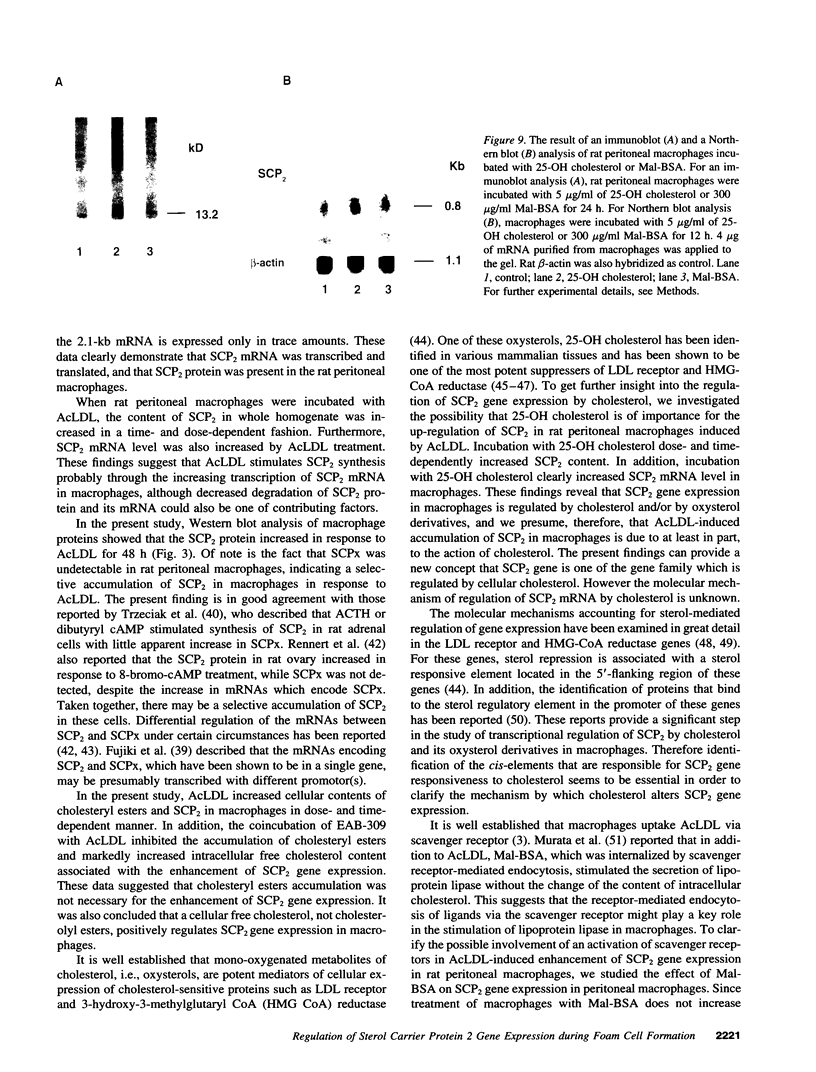
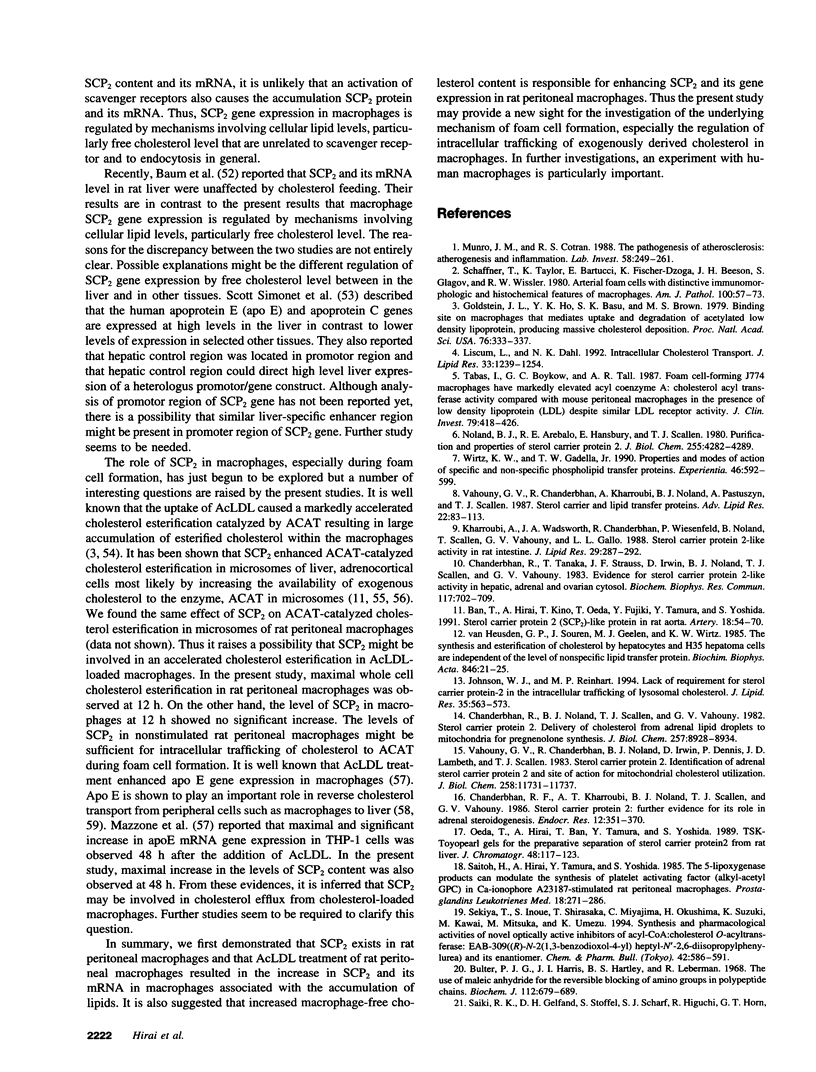
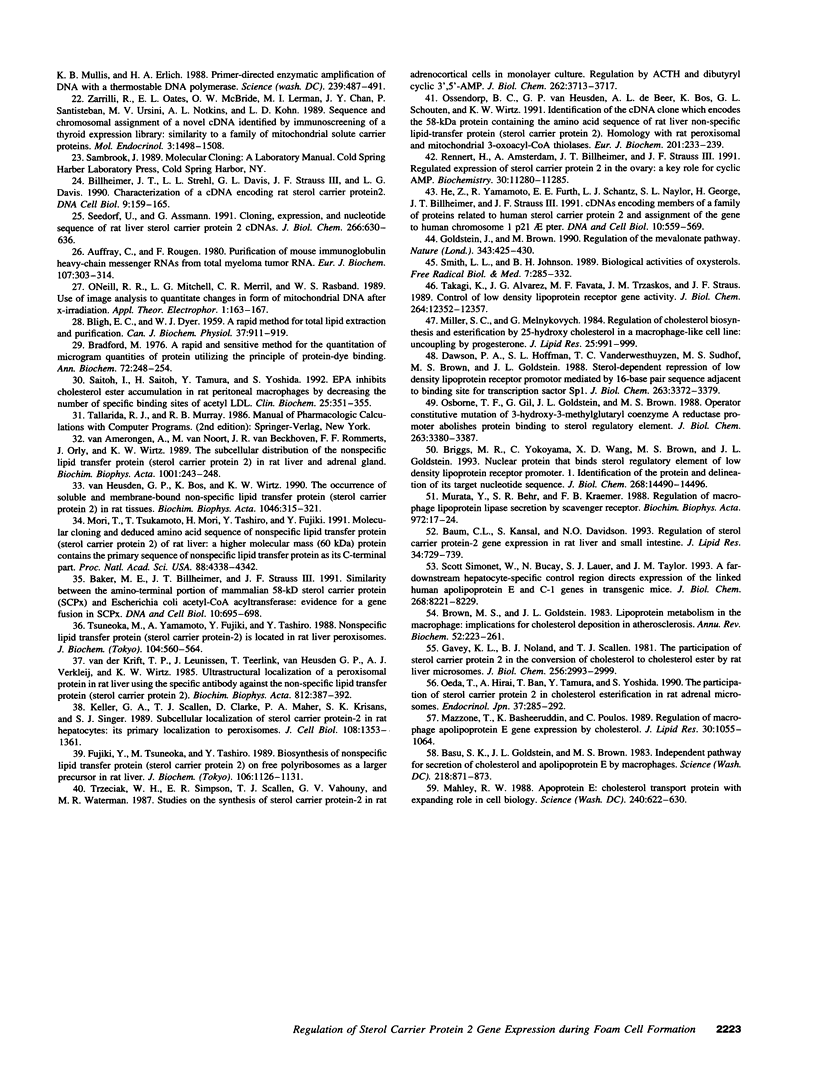
Images in this article
Selected References
These references are in PubMed. This may not be the complete list of references from this article.
- Auffray C., Rougeon F. Purification of mouse immunoglobulin heavy-chain messenger RNAs from total myeloma tumor RNA. Eur J Biochem. 1980 Jun;107(2):303–314. doi: 10.1111/j.1432-1033.1980.tb06030.x. [DOI] [PubMed] [Google Scholar]
- BLIGH E. G., DYER W. J. A rapid method of total lipid extraction and purification. Can J Biochem Physiol. 1959 Aug;37(8):911–917. doi: 10.1139/o59-099. [DOI] [PubMed] [Google Scholar]
- Baker M. E., Billheimer J. T., Strauss J. F., 3rd Similarity between the amino-terminal portion of mammalian 58-kD sterol carrier protein (SCPx) and Escherichia coli acetyl-CoA acyltransferase: evidence for a gene fusion in SCPx. DNA Cell Biol. 1991 Nov;10(9):695–698. doi: 10.1089/dna.1991.10.695. [DOI] [PubMed] [Google Scholar]
- Ban T., Hirai A., Kino T., Oeda T., Fujiki Y., Tamura Y., Yoshida S. Sterol carrier protein2 (SCP2)-like protein in rat aorta. Artery. 1991;18(2):54–70. [PubMed] [Google Scholar]
- Basu S. K., Goldstein J. L., Brown M. S. Independent pathways for secretion of cholesterol and apolipoprotein E by macrophages. Science. 1983 Feb 18;219(4586):871–873. doi: 10.1126/science.6823554. [DOI] [PubMed] [Google Scholar]
- Baum C. L., Kansal S., Davidson N. O. Regulation of sterol carrier protein-2 gene expression in rat liver and small intestine. J Lipid Res. 1993 May;34(5):729–739. [PubMed] [Google Scholar]
- Billheimer J. T., Strehl L. L., Davis G. L., Strauss J. F., 3rd, Davis L. G. Characterization of a cDNA encoding rat sterol carrier protein2. DNA Cell Biol. 1990 Apr;9(3):159–165. doi: 10.1089/dna.1990.9.159. [DOI] [PubMed] [Google Scholar]
- Bradford M. M. A rapid and sensitive method for the quantitation of microgram quantities of protein utilizing the principle of protein-dye binding. Anal Biochem. 1976 May 7;72:248–254. doi: 10.1016/0003-2697(76)90527-3. [DOI] [PubMed] [Google Scholar]
- Briggs M. R., Yokoyama C., Wang X., Brown M. S., Goldstein J. L. Nuclear protein that binds sterol regulatory element of low density lipoprotein receptor promoter. I. Identification of the protein and delineation of its target nucleotide sequence. J Biol Chem. 1993 Jul 5;268(19):14490–14496. [PubMed] [Google Scholar]
- Brown M. S., Goldstein J. L. Lipoprotein metabolism in the macrophage: implications for cholesterol deposition in atherosclerosis. Annu Rev Biochem. 1983;52:223–261. doi: 10.1146/annurev.bi.52.070183.001255. [DOI] [PubMed] [Google Scholar]
- Butler P. J., Harris J. I., Hartley B. S., Lebeman R. The use of maleic anhydride for the reversible blocking of amino groups in polypeptide chains. Biochem J. 1969 May;112(5):679–689. doi: 10.1042/bj1120679. [DOI] [PMC free article] [PubMed] [Google Scholar]
- Chanderbhan R. F., Kharroubi A. T., Noland B. J., Scallen T. J., Vahouny G. V. Sterol carrier protein2: further evidence for its role in adrenal steroidogenesis. Endocr Res. 1986;12(4):351–370. doi: 10.3109/07435808609035445. [DOI] [PubMed] [Google Scholar]
- Chanderbhan R., Noland B. J., Scallen T. J., Vahouny G. V. Sterol carrier protein2. Delivery of cholesterol from adrenal lipid droplets to mitochondria for pregnenolone synthesis. J Biol Chem. 1982 Aug 10;257(15):8928–8934. [PubMed] [Google Scholar]
- Chanderbhan R., Tanaka T., Strauss J. F., Irwin D., Noland B. J., Scallen T. J., Vahouny G. V. Evidence for sterol carrier protein2-like activity in hepatic, adrenal and ovarian cytosol. Biochem Biophys Res Commun. 1983 Dec 28;117(3):702–709. doi: 10.1016/0006-291x(83)91654-6. [DOI] [PubMed] [Google Scholar]
- Dawson P. A., Hofmann S. L., van der Westhuyzen D. R., Südhof T. C., Brown M. S., Goldstein J. L. Sterol-dependent repression of low density lipoprotein receptor promoter mediated by 16-base pair sequence adjacent to binding site for transcription factor Sp1. J Biol Chem. 1988 Mar 5;263(7):3372–3379. [PubMed] [Google Scholar]
- Fujiki Y., Tsuneoka M., Tashiro Y. Biosynthesis of nonspecific lipid transfer protein (sterol carrier protein 2) on free polyribosomes as a larger precursor in rat liver. J Biochem. 1989 Dec;106(6):1126–1131. doi: 10.1093/oxfordjournals.jbchem.a122977. [DOI] [PubMed] [Google Scholar]
- Gavey K. L., Noland B. J., Scallen T. J. The participation of sterol carrier protein2 in the conversion of cholesterol to cholesterol ester by rat liver microsomes. J Biol Chem. 1981 Mar 25;256(6):2993–2999. [PubMed] [Google Scholar]
- Goldstein J. L., Brown M. S. Regulation of the mevalonate pathway. Nature. 1990 Feb 1;343(6257):425–430. doi: 10.1038/343425a0. [DOI] [PubMed] [Google Scholar]
- Goldstein J. L., Ho Y. K., Basu S. K., Brown M. S. Binding site on macrophages that mediates uptake and degradation of acetylated low density lipoprotein, producing massive cholesterol deposition. Proc Natl Acad Sci U S A. 1979 Jan;76(1):333–337. doi: 10.1073/pnas.76.1.333. [DOI] [PMC free article] [PubMed] [Google Scholar]
- He Z., Yamamoto R., Furth E. E., Schantz L. J., Naylor S. L., George H., Billheimer J. T., Strauss J. F., 3rd cDNAs encoding members of a family of proteins related to human sterol carrier protein 2 and assignment of the gene to human chromosome 1 p21----pter. DNA Cell Biol. 1991 Oct;10(8):559–569. doi: 10.1089/dna.1991.10.559. [DOI] [PubMed] [Google Scholar]
- Johnson W. J., Reinhart M. P. Lack of requirement for sterol carrier protein-2 in the intracellular trafficking of lysosomal cholesterol. J Lipid Res. 1994 Apr;35(4):563–573. [PubMed] [Google Scholar]
- Keller G. A., Scallen T. J., Clarke D., Maher P. A., Krisans S. K., Singer S. J. Subcellular localization of sterol carrier protein-2 in rat hepatocytes: its primary localization to peroxisomes. J Cell Biol. 1989 Apr;108(4):1353–1361. doi: 10.1083/jcb.108.4.1353. [DOI] [PMC free article] [PubMed] [Google Scholar]
- Kharroubi A., Wadsworth J. A., Chanderbhan R., Wiesenfeld P., Noland B., Scallen T., Vahouny G. V., Gallo L. L. Sterol carrier protein2-like activity in rat intestine. J Lipid Res. 1988 Mar;29(3):287–292. [PubMed] [Google Scholar]
- Liscum L., Dahl N. K. Intracellular cholesterol transport. J Lipid Res. 1992 Sep;33(9):1239–1254. [PubMed] [Google Scholar]
- Mahley R. W. Apolipoprotein E: cholesterol transport protein with expanding role in cell biology. Science. 1988 Apr 29;240(4852):622–630. doi: 10.1126/science.3283935. [DOI] [PubMed] [Google Scholar]
- Mazzone T., Basheeruddin K., Poulos C. Regulation of macrophage apolipoprotein E gene expression by cholesterol. J Lipid Res. 1989 Jul;30(7):1055–1064. [PubMed] [Google Scholar]
- Miller S. C., Melnykovych G. Regulation of cholesterol biosynthesis and esterification by 25-hydroxycholesterol in a macrophage-like cell line: uncoupling by progesterone. J Lipid Res. 1984 Sep;25(9):991–999. [PubMed] [Google Scholar]
- Mori T., Tsukamoto T., Mori H., Tashiro Y., Fujiki Y. Molecular cloning and deduced amino acid sequence of nonspecific lipid transfer protein (sterol carrier protein 2) of rat liver: a higher molecular mass (60 kDa) protein contains the primary sequence of nonspecific lipid transfer protein as its C-terminal part. Proc Natl Acad Sci U S A. 1991 May 15;88(10):4338–4342. doi: 10.1073/pnas.88.10.4338. [DOI] [PMC free article] [PubMed] [Google Scholar]
- Munro J. M., Cotran R. S. The pathogenesis of atherosclerosis: atherogenesis and inflammation. Lab Invest. 1988 Mar;58(3):249–261. [PubMed] [Google Scholar]
- Murata Y., Behr S. R., Kraemer F. B. Regulation of macrophage lipoprotein lipase secretion by the scavenger receptor. Biochim Biophys Acta. 1988 Oct 28;972(1):17–24. doi: 10.1016/0167-4889(88)90097-3. [DOI] [PubMed] [Google Scholar]
- Noland B. J., Arebalo R. E., Hansbury E., Scallen T. J. Purification and properties of sterol carrier protein2. J Biol Chem. 1980 May 10;255(9):4282–4289. [PubMed] [Google Scholar]
- O'Neill R. R., Mitchell L. G., Merril C. R., Rasband W. S. Use of image analysis to quantitate changes in form of mitochondrial DNA after x-irradiation. Appl Theor Electrophor. 1989;1(3):163–167. [PubMed] [Google Scholar]
- Oeda T., Hirai A., Ban T., Tamura Y., Yoshida S. TSK-Toyopearl gels for the preparative separation of sterol carrier protein2 from rat liver. J Chromatogr. 1989 Nov 17;482(1):117–123. doi: 10.1016/s0021-9673(01)93212-1. [DOI] [PubMed] [Google Scholar]
- Oeda T., Hirai A., Ban T., Tamura Y., Yoshida S. The participation of sterol carrier protein2 in cholesterol esterification in rat adrenal microsomes. Endocrinol Jpn. 1990 Apr;37(2):285–292. doi: 10.1507/endocrj1954.37.285. [DOI] [PubMed] [Google Scholar]
- Osborne T. F., Gil G., Goldstein J. L., Brown M. S. Operator constitutive mutation of 3-hydroxy-3-methylglutaryl coenzyme A reductase promoter abolishes protein binding to sterol regulatory element. J Biol Chem. 1988 Mar 5;263(7):3380–3387. [PubMed] [Google Scholar]
- Ossendorp B. C., Van Heusden G. P., De Beer A. L., Bos K., Schouten G. L., Wirtz K. W. Identification of the cDNA clone which encodes the 58-kDa protein containing the amino acid sequence of rat liver non-specific lipid-transfer protein (sterol-carrier protein 2). Homology with rat peroxisomal and mitochondrial 3-oxoacyl-CoA thiolases. Eur J Biochem. 1991 Oct 1;201(1):233–239. doi: 10.1111/j.1432-1033.1991.tb16279.x. [DOI] [PubMed] [Google Scholar]
- Rennert H., Amsterdam A., Billheimer J. T., Strauss J. F., 3rd Regulated expression of sterol carrier protein 2 in the ovary: a key role for cyclic AMP. Biochemistry. 1991 Nov 26;30(47):11280–11285. doi: 10.1021/bi00111a013. [DOI] [PubMed] [Google Scholar]
- Saiki R. K., Gelfand D. H., Stoffel S., Scharf S. J., Higuchi R., Horn G. T., Mullis K. B., Erlich H. A. Primer-directed enzymatic amplification of DNA with a thermostable DNA polymerase. Science. 1988 Jan 29;239(4839):487–491. doi: 10.1126/science.2448875. [DOI] [PubMed] [Google Scholar]
- Saito H., Hirai A., Tamura Y., Yoshida S. The 5-lipoxygenase products can modulate the synthesis of platelet-activating factor (alkyl-acetyl GPC) in Ca-ionophore A23187-stimulated rat peritoneal macrophages. Prostaglandins Leukot Med. 1985 Jun;18(3):271–286. doi: 10.1016/0262-1746(85)90059-9. [DOI] [PubMed] [Google Scholar]
- Saito I., Saito H., Tamura Y., Yoshida S. Eicosapentaenoic acid inhibits cholesteryl ester accumulation in rat peritoneal macrophages by decreasing the number of specific binding sites of acetyl LDL. Clin Biochem. 1992 Oct;25(5):351–355. doi: 10.1016/0009-9120(92)80015-9. [DOI] [PubMed] [Google Scholar]
- Schaffner T., Taylor K., Bartucci E. J., Fischer-Dzoga K., Beeson J. H., Glagov S., Wissler R. W. Arterial foam cells with distinctive immunomorphologic and histochemical features of macrophages. Am J Pathol. 1980 Jul;100(1):57–80. [PMC free article] [PubMed] [Google Scholar]
- Seedorf U., Assmann G. Cloning, expression, and nucleotide sequence of rat liver sterol carrier protein 2 cDNAs. J Biol Chem. 1991 Jan 5;266(1):630–636. [PubMed] [Google Scholar]
- Sekiya T., Inoue S., Shirasaka T., Miyajima C., Okushima H., Suzuki K., Kawai M., Mitsuka M., Umezu K. Syntheses and pharmacological activities of novel optically active inhibitors of acyl-CoA: cholesterol O-acyltransferase: EAB-309 ((R)-N-2-(1,3-benzodioxol-4-yl)heptyl-N'-2,6-diisopropylphenylurea) and its enantiomer. Chem Pharm Bull (Tokyo) 1994 Mar;42(3):586–591. doi: 10.1248/cpb.42.586. [DOI] [PubMed] [Google Scholar]
- Simonet W. S., Bucay N., Lauer S. J., Taylor J. M. A far-downstream hepatocyte-specific control region directs expression of the linked human apolipoprotein E and C-I genes in transgenic mice. J Biol Chem. 1993 Apr 15;268(11):8221–8229. [PubMed] [Google Scholar]
- Smith L. L., Johnson B. H. Biological activities of oxysterols. Free Radic Biol Med. 1989;7(3):285–332. doi: 10.1016/0891-5849(89)90136-6. [DOI] [PubMed] [Google Scholar]
- Tabas I., Boykow G. C., Tall A. R. Foam cell-forming J774 macrophages have markedly elevated acyl coenzyme A:cholesterol acyl transferase activity compared with mouse peritoneal macrophages in the presence of low density lipoprotein (LDL) despite similar LDL receptor activity. J Clin Invest. 1987 Feb;79(2):418–426. doi: 10.1172/JCI112828. [DOI] [PMC free article] [PubMed] [Google Scholar]
- Takagi K., Alvarez J. G., Favata M. F., Trzaskos J. M., Strauss J. F., 3rd Control of low density lipoprotein receptor gene promoter activity. Ketoconazole inhibits serum lipoprotein but not oxysterol suppression of gene transcription. J Biol Chem. 1989 Jul 25;264(21):12352–12357. [PubMed] [Google Scholar]
- Trzeciak W. H., Simpson E. R., Scallen T. J., Vahouny G. V., Waterman M. R. Studies on the synthesis of sterol carrier protein-2 in rat adrenocortical cells in monolayer culture. Regulation by ACTH and dibutyryl cyclic 3',5'-AMP. J Biol Chem. 1987 Mar 15;262(8):3713–3717. [PubMed] [Google Scholar]
- Tsuneoka M., Yamamoto A., Fujiki Y., Tashiro Y. Nonspecific lipid transfer protein (sterol carrier protein-2) is located in rat liver peroxisomes. J Biochem. 1988 Oct;104(4):560–564. doi: 10.1093/oxfordjournals.jbchem.a122510. [DOI] [PubMed] [Google Scholar]
- Vahouny G. V., Chanderbhan R., Kharroubi A., Noland B. J., Pastuszyn A., Scallen T. J. Sterol carrier and lipid transfer proteins. Adv Lipid Res. 1987;22:83–113. doi: 10.1016/b978-0-12-024922-0.50007-2. [DOI] [PubMed] [Google Scholar]
- Vahouny G. V., Chanderbhan R., Noland B. J., Irwin D., Dennis P., Lambeth J. D., Scallen T. J. Sterol carrier protein2. Identification of adrenal sterol carrier protein2 and site of action for mitochondrial cholesterol utilization. J Biol Chem. 1983 Oct 10;258(19):11731–11737. [PubMed] [Google Scholar]
- Van Heusden G. P., Bos K., Wirtz K. W. The occurrence of soluble and membrane-bound non-specific lipid transfer protein (sterol carrier protein 2) in rat tissues. Biochim Biophys Acta. 1990 Oct 1;1046(3):315–321. doi: 10.1016/0005-2760(90)90247-u. [DOI] [PubMed] [Google Scholar]
- Van der Krift T. P., Leunissen J., Teerlink T., Van Heusden G. P., Verkleij A. J., Wirtz K. W. Ultrastructural localization of a peroxisomal protein in rat liver using the specific antibody against the non-specific lipid transfer protein (sterol carrier protein 2). Biochim Biophys Acta. 1985 Jan 25;812(2):387–392. doi: 10.1016/0005-2736(85)90313-x. [DOI] [PubMed] [Google Scholar]
- Wirtz K. W., Gadella T. W., Jr Properties and modes of action of specific and non-specific phospholipid transfer proteins. Experientia. 1990 Jun 15;46(6):592–599. doi: 10.1007/BF01939698. [DOI] [PubMed] [Google Scholar]
- Zarrilli R., Oates E. L., McBride O. W., Lerman M. I., Chan J. Y., Santisteban P., Ursini M. V., Notkins A. L., Kohn L. D. Sequence and chromosomal assignment of a novel cDNA identified by immunoscreening of a thyroid expression library: similarity to a family of mitochondrial solute carrier proteins. Mol Endocrinol. 1989 Sep;3(9):1498–1505. doi: 10.1210/mend-3-9-1498. [DOI] [PubMed] [Google Scholar]
- van Amerongen A., van Noort M., van Beckhoven J. R., Rommerts F. F., Orly J., Wirtz K. W. The subcellular distribution of the nonspecific lipid transfer protein (sterol carrier protein 2) in rat liver and adrenal gland. Biochim Biophys Acta. 1989 Feb 20;1001(3):243–248. doi: 10.1016/0005-2760(89)90106-9. [DOI] [PubMed] [Google Scholar]
- van Heusden G. P., Souren J., Geelen M. J., Wirtz K. W. The synthesis and esterification of cholesterol by hepatocytes and H35 hepatoma cells are independent of the level of nonspecific lipid transfer protein. Biochim Biophys Acta. 1985 Jul 30;846(1):21–25. doi: 10.1016/0167-4889(85)90105-3. [DOI] [PubMed] [Google Scholar]





